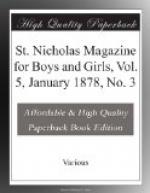A pretty little dish of boiled rice, with a cake of molasses, or preserve of some sort, in the middle. This, fitted into a basket, and covered with a plate, goes safely, and, with the addition of a napkin and two spoons, makes a simple meal for hungry children.
It may find favor in the eyes, or rather mouths, of the young readers of ST. NICHOLAS, not only because it is good, but because it was the favorite lunch once upon a time of two little girls who are now pretty well known as “Meg and Jo March.” It may be well to add that these young persons never had dyspepsia in their lives,—pie and pickles, cake and candy being unknown “goodies” to them.
With best wishes for the success
of this much-needed reform in
school-children’s diet,
I am, yours truly,
L.M.A.
* * * * *
THE MOONS OF MARS.
Since Professor Proctor wrote the paper entitled “Mars, the Planet of War,” published in this number, there has been made, in relation to its subject, a discovery that the scientists say will rank among the most brilliant achievements of astronomy.
A great difference once thought to exist between Mars and the other planets was that he had no moons; but during the night of the 16th of August, Professor Hall, of the U.S. Naval Observatory at Washington, D.C., actually saw through his telescope that Mars has a moon. On the 18th of August another was seen, smaller than the first and nearer to the planet. The larger satellite is believed to be not more than ten miles in diameter: it is less than 12,000 miles distant from its primary, and its period of revolution about it is 30 hours 14 minutes. The distance of the smaller moon is 3,300 miles, and its period 7 hours 38 minutes. There is no doubt that these newly found celestial bodies are the smallest known.
From measurements made by Professor Hall, it is found, with a near approach to certainty, that the mass of Mars is equal to 1-3,090,000th part of the mass of the sun. This result was arrived at after only ten minutes of calculation, and is believed to be more nearly accurate than that obtained by M. Le Verrier, the great French astronomer, from observations continued through a century and after several years of laborious calculation by a corps of computers. This wonderful difference in the expenditure of time and labor is due to the vigilance of Professor Hall and to the admirable qualities of his instrument, the great twenty-six inch refracting telescope made by Alvan Clark & Sons.
* * * * *
Oakland, Cal.
DEAR ST. NICHOLAS: I do not wish to make you any trouble, but I would like it very much if you could find room in some number to give a good explanation of the great war in Europe. I can’t understand it in the newspaper, but I am pretty sure you can make it plain and simple enough for all of your young readers.—Yours truly,
NEB.




